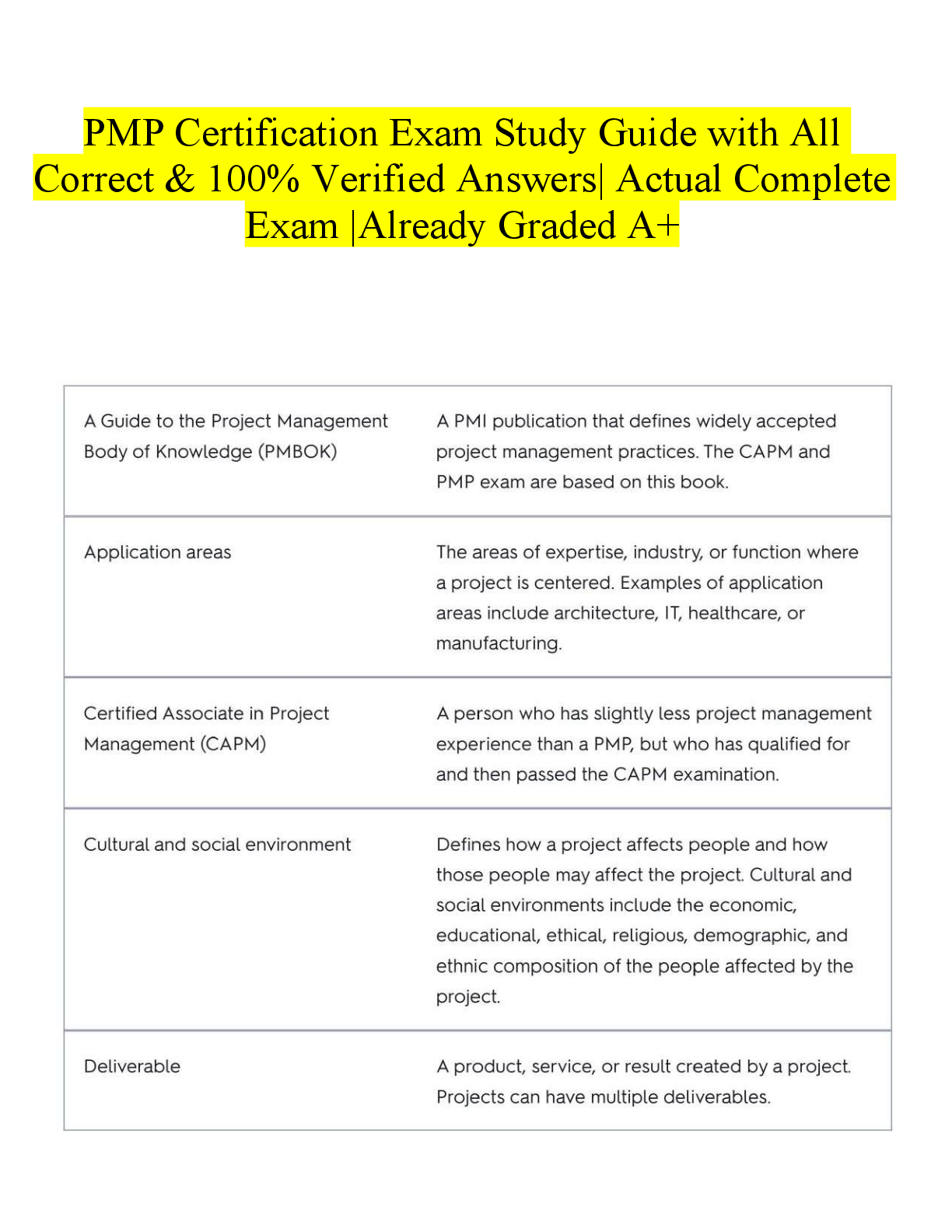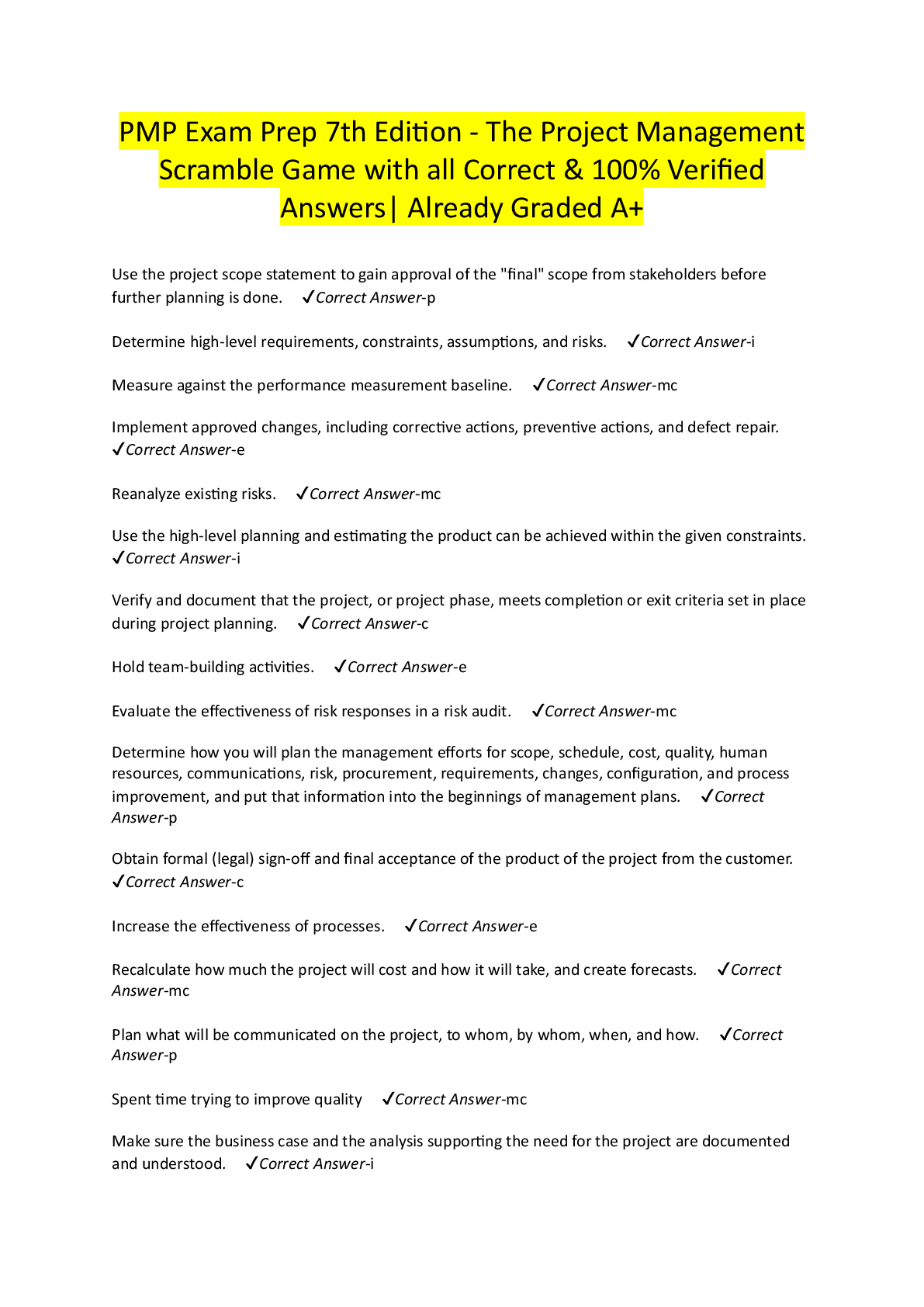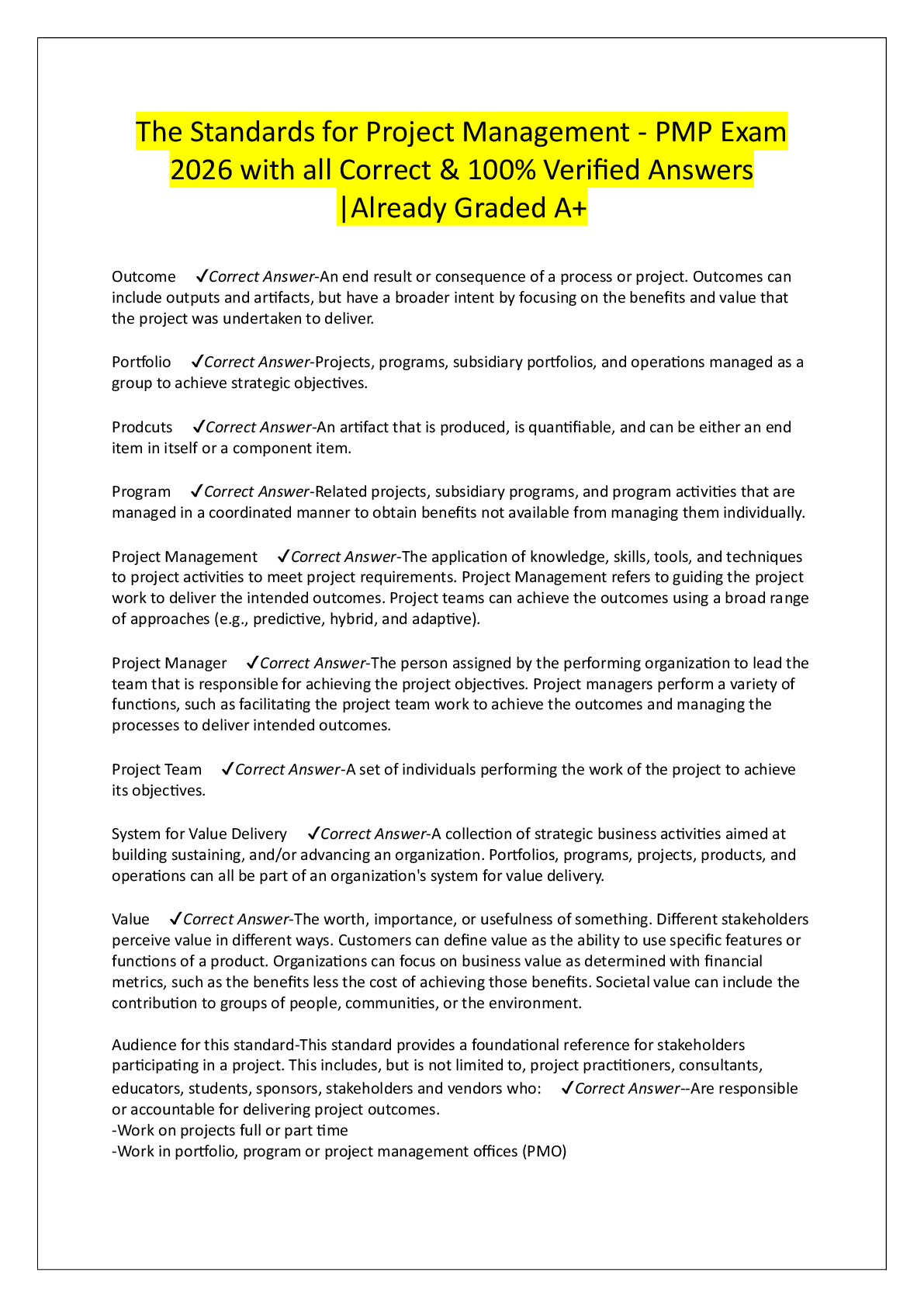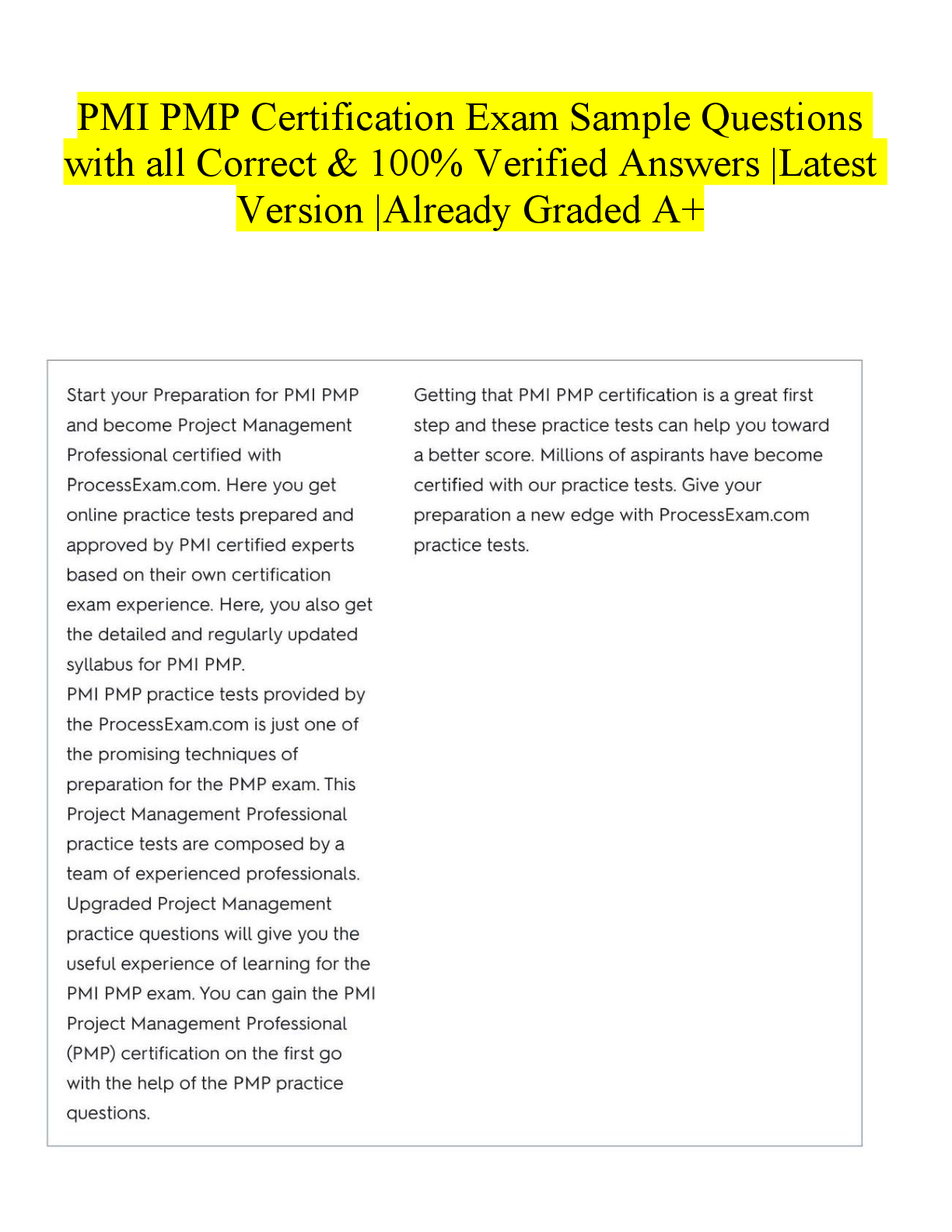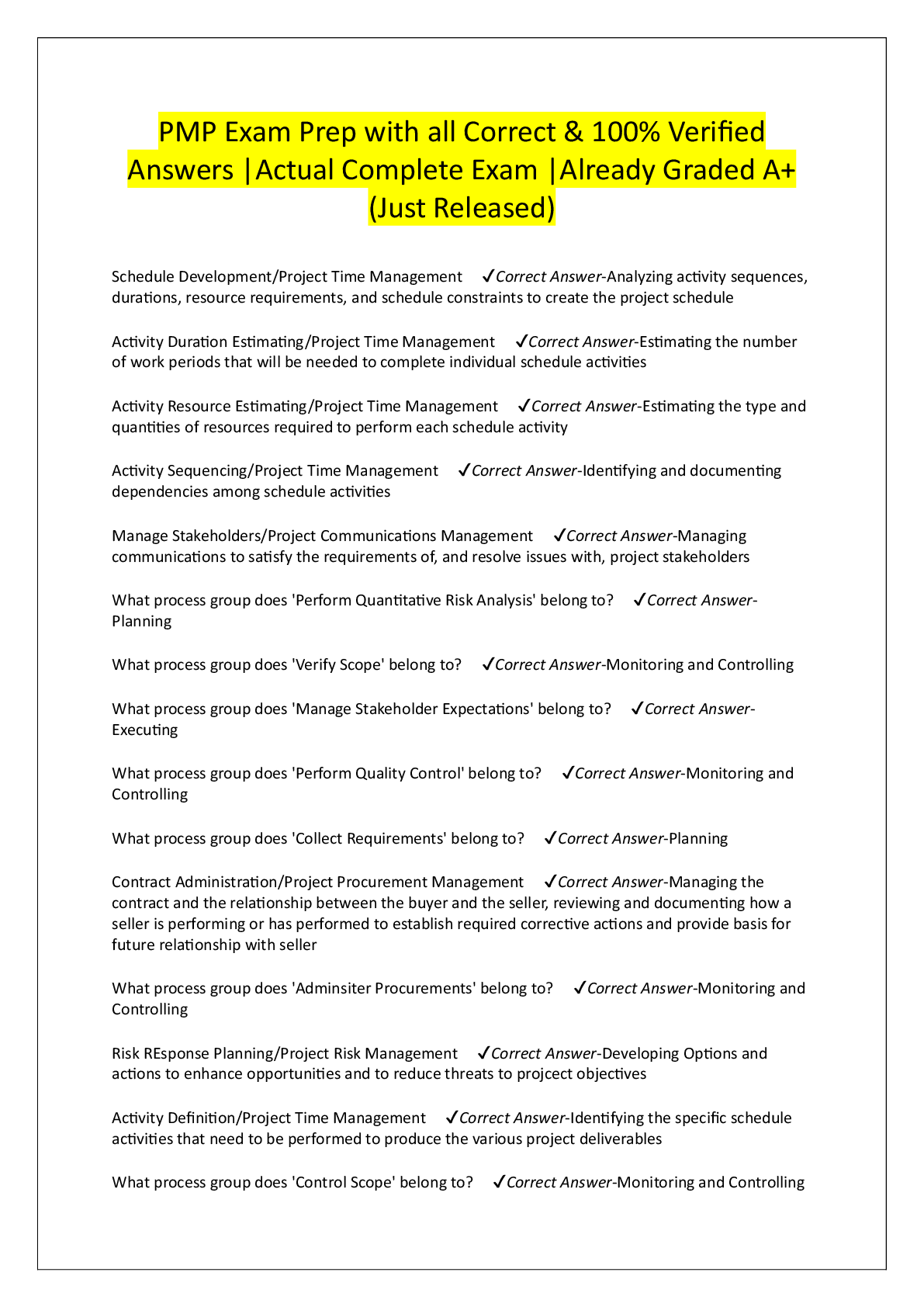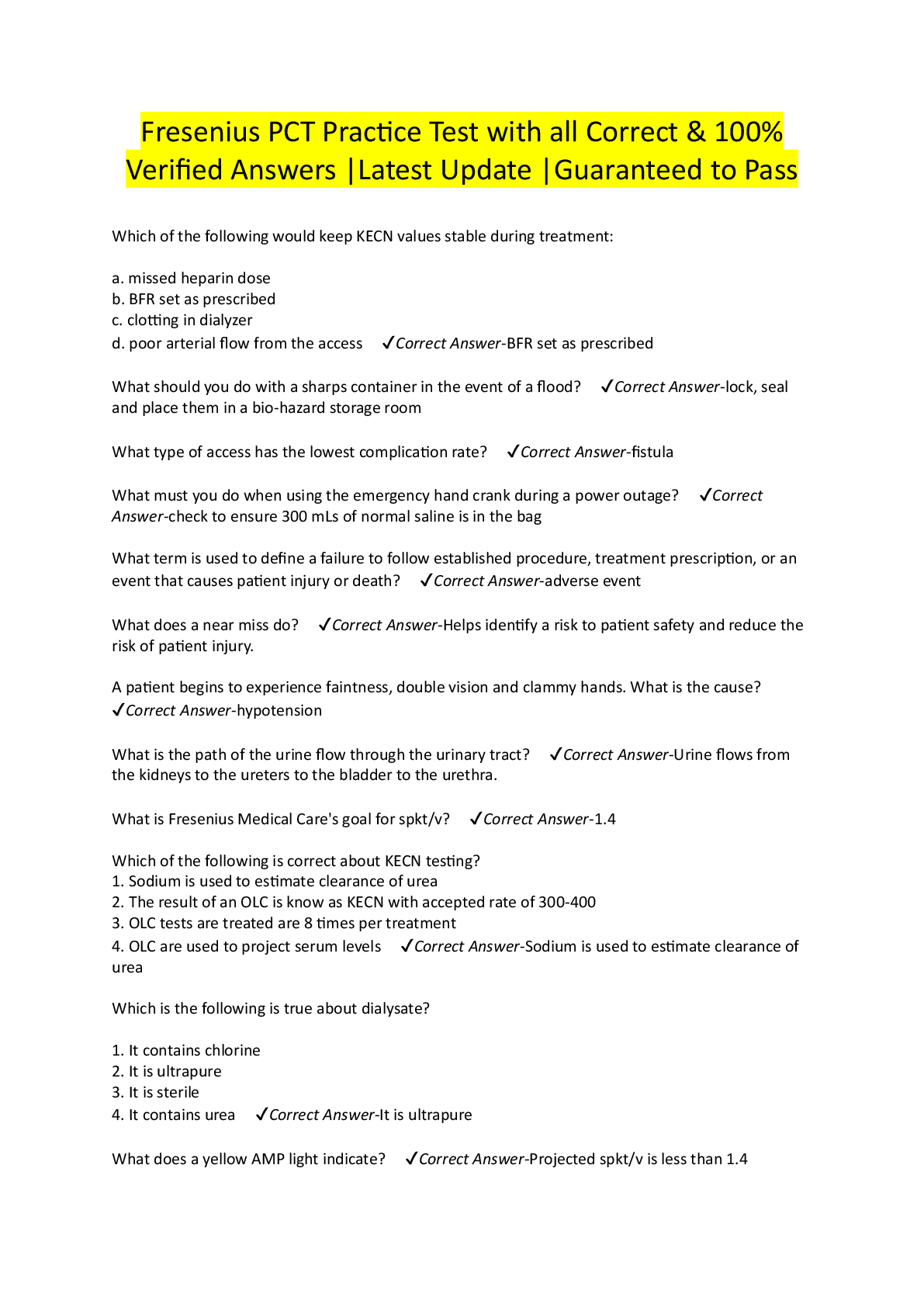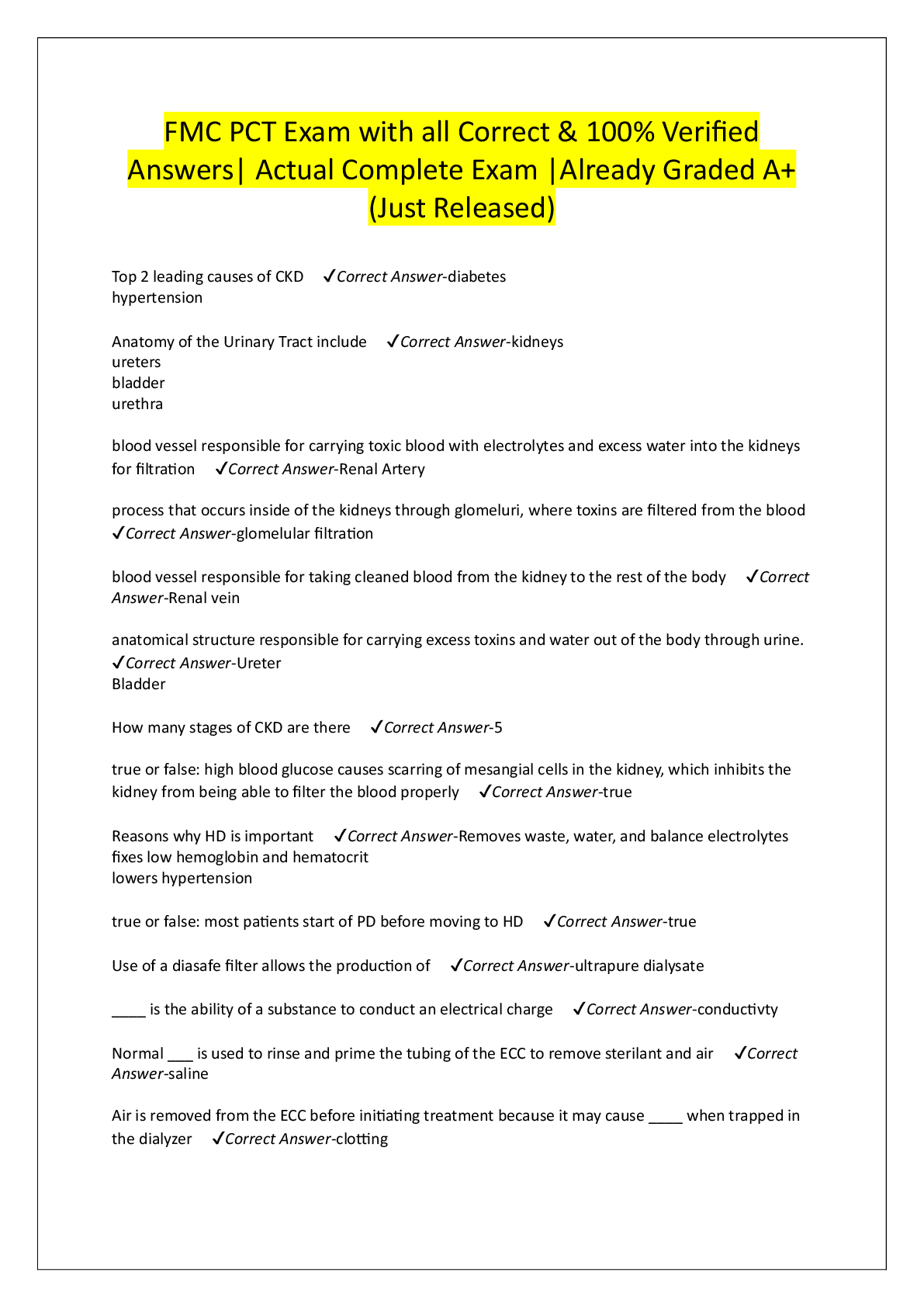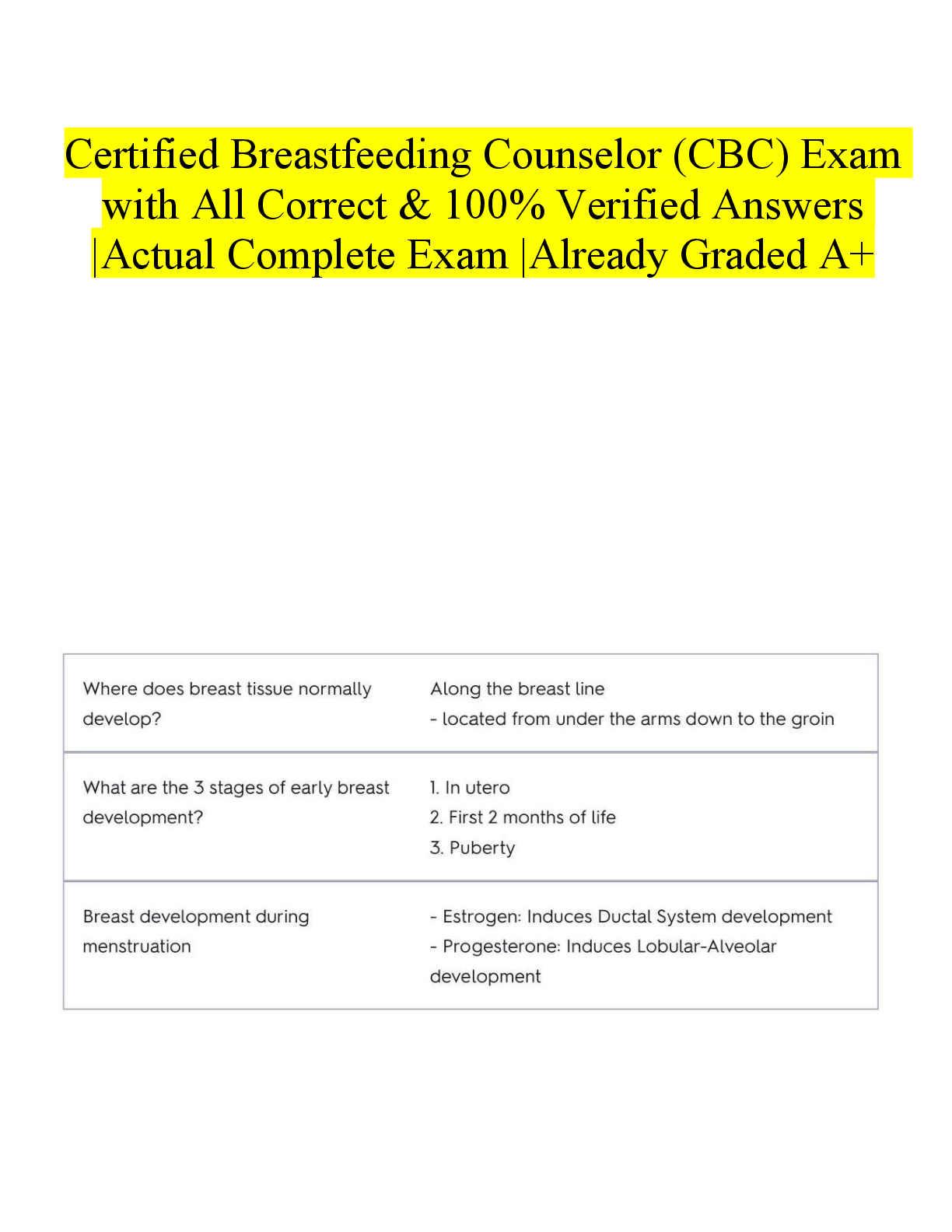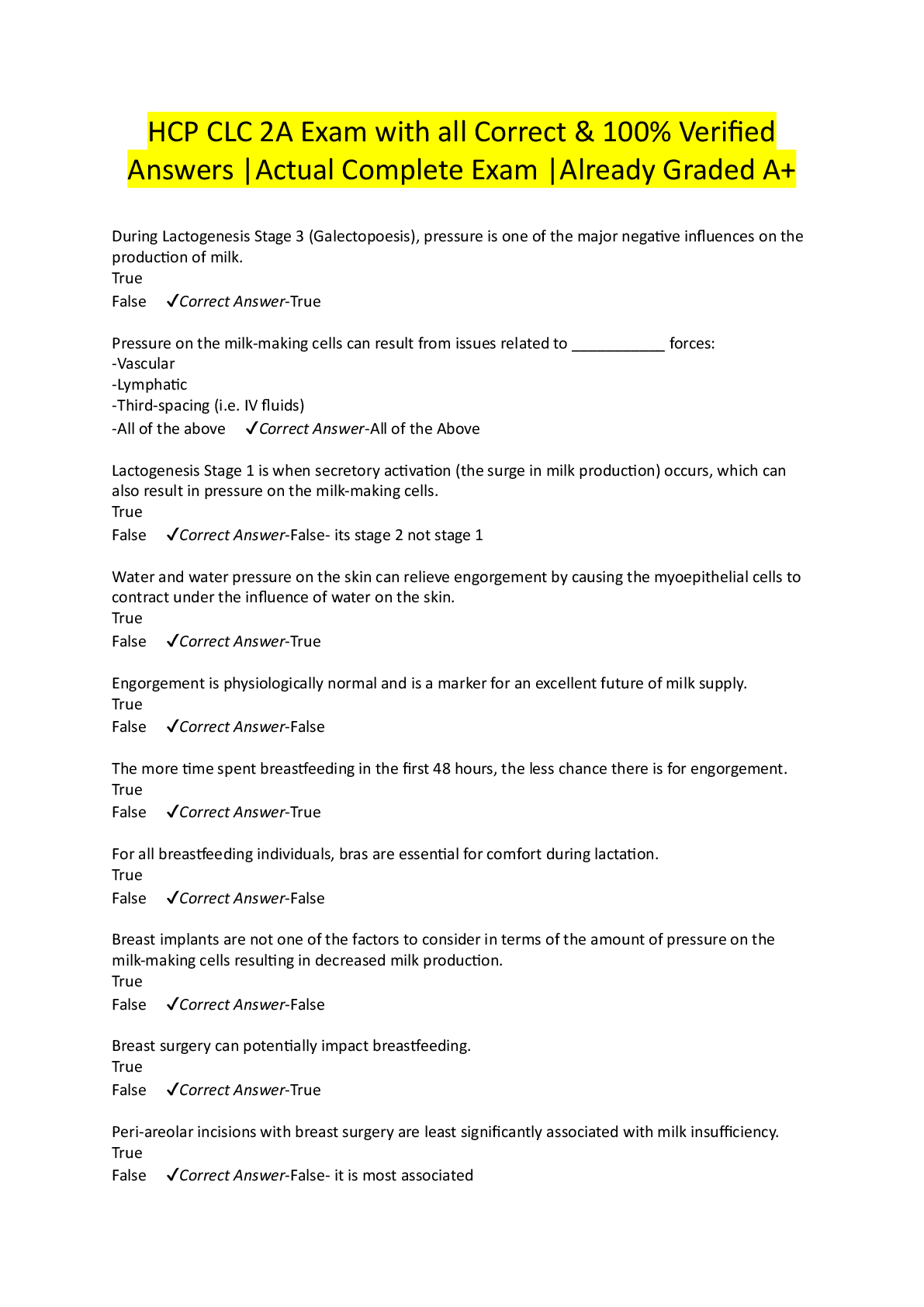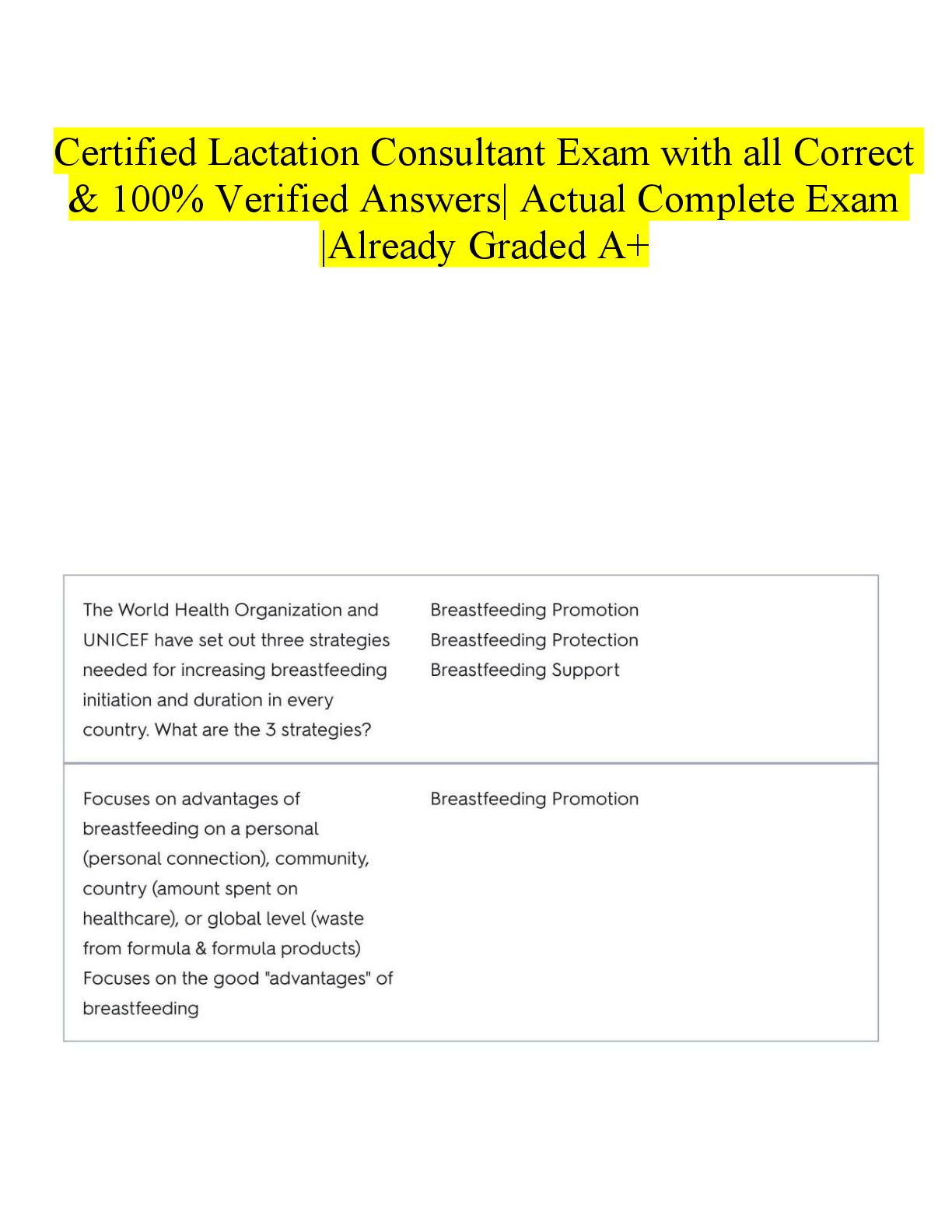NURS 20375 predictor questions & answers 2020/2021
Document Content and Description Below
NURS 20375 predictor hesi questions & answers 1. The nurse mixes 250 mg of D5W dobutamine and plans to administer the solution at a rate of 15 mcg/kg/minute to a client weighing 110 pounds. The nu ... rse should set the infusion pump to administer how many ml per hour? (Enter numeric value only rounding is required, round to the nearest whole number) 2. A male client is admitted to the hospital with a medical diagnosis of peptic ulcers. The nurse should inform the client that he is most likely to experience the greatest pain and discomforting which situation? a. After consuming a high-fat meal b. When the stomach is full. c. After consuming an extremely cold beverage d. When the stomach is empty 3. A client in the third trimester of pregnancy reports that she feels some "lumpy places" in her breasts and that her nipples sometimes leak a yellowish fluid. She has an appointment with her healthcare provider in two weeks. What action should the nurse take? a. A Reschedule the client's prenatal appointment for the following day b. B Recommend that the client start wearing a supportive brassiere c. C Tell the client to begin nipple stimulation to prepare for breast feeding d. D Explain that this normal secretion can be assessed at the next visit 4. An older adult client is admitted to the stroke unit after recovery from the acute phrase of an ischemic cerebral vascular accident (CAV). which interventions should the nurse include in the plan of care during convalescence and rehabilitation? (Select all that apply.) a. Measure neurological vital signs every 4 hours b. Place a bed side commode next to bed c. Suction oral cavity every 4 hours. d. Encourage family participate in the client's care e. Play classical music in room while client is awake 5. A female client with a history of heart failure (HF) arrives at the clinic after what she describes as a very long trip. Following the initial physical assessment and chart review, which prior action should the nurse implement? (click on each chart for additional information. Please be sure to scroll to the bottom right corner of each tab to view all information contained in the client's medical record) a. Reteach medication regimen b. Administer the prescribed diuretic c. Auscultate lung and heart sounds d. Give a potassium supplement. 6. Which information is most important to include in the teaching plan for a client who is discharged after a thyroidectomy for Grave’s disease? a. The need to use more blankets at night or extra clothing should be reported b. A high fiber diet with adequate fluid intake should be followed c. Meticulous eye care with artificial tears should be used daily d. Daily hormone replacement will be needed for the rest of the client’s life 7. An older male client, who is a retired chef, is hospitalized with a diabetic ulcer on his foot His daughter tells the nurse that her father has become increasingly obsessed with the way his food is prepared in the hospital The nurse's response should be based on what information? a. The client probably has an organic brain disease and will likely have Alzheimers disease within a few years. b. The family needs a social worker to talk to them about how to handle their father when he becomes annoying c. The daughter is under stress and should be encouraged to think about happier times d. The client was compulsive about food when he was younger, the aging process can magnify this 8. Following a motor vehicle collision (MVC), an unrestrained female client is admitted to the intensive care unit with altered mental status. She has multiple rib fractures and bruising across her lower abdomen. Which assessment finding warrants immediate intervention by the nurse? (Please scroll and view each tab's information in the client's medical record before selecting the answer) a. A large amount of gross hematuria b. Several apnea episodes lasting ten seconds c. Delayed peripheral capillary refill. d. Numbness of the left lower extremity 10. A client with syndrome of inappropriate antidiuretic hormone (SIADH) is admitted with a weight gain of 4.4 lbs (2 kg) in 24 hours and an elevated pulse rate. Which intervention should the nurse implement first? a. Review arterial blood gas results b. Monitor daily sodium intake c. Record usual eating patterns d. Ensure client takes a diuretic every morning 11.What is the priority nursing problem for a client with hypoparathyroidism? a. Risk for injury. b. Deficient knowledge c. Anxiety d. imbalanced nutrition 12. A male client with cirrhosis and severe ascites, who is scheduled for a paracentesis tells the nurse that he is in pain and feels short of breath, so he wants to reschedule the procedure. How should the nurse respond? a. Encourage the client to verbalize his tears about the outcome of the procedure b. Offer to notify the healthcare provider of his desire to reschedule the procedure c. Advise the client that the procedure will help diagnose the cause of his symptoms d. Explain the client that the paracentesis will provide relief from his discomfort. 13. After having a pulmonary angiogram, a client is diagnosed with a pulmonary embolism (PE). Which intervention is most important for the nurse to include in the client's plan of care? a. Monitor for confusion and restlessness. b. Observe for signs of increased bleeding. c. Administer IV opiods as needed for pain. d. Teach how to use incentive spirometry. 14. A client with chronic renal insufficiency is preparing for discharge from the hospital. Which information is most important for the nurse to include in this client's discharge teaching? a. Use of topical application to manage pruritus b. Need for maintaining good oral hygiene. c. Strategies to promote independent self-care. d. Instructions regarding a restricted protein diet 15. The client provides three positive responses to items on the CAGE (cut down, Annoyed, Guilty, Eye-opener) Questionnaire. What interpretation should the nurse provide the client? a. The CAGE questionnaire is a tool used to identify general substance abuse b. At least two positive responses are strongly suggestive of alcohol dependence c. One positive response indicates the client should seek help with alcohol addiction d. All responses to the CAGE questionnaire must be positive to suggest alcohol dependence 16. The nurse observes a practical nurse (PN) pouring warm water over the perineal area of a female client who has frequent urinary incontinence while the client is positioned on a bedpan. What action should the nurse take? Recommend a complete bath to cleanse the perineal area more fully a. Suggest contacting the healthcare provider for a prescription for catheter insertion b. Evaluate the effectiveness of this measure to client c. Instruct the PN that this technique promotes infection in elderly females 17. 32. 37.5 ml 18. The nurse should expect a client diagnosed with regional enteritis (crohn's disease) to exhibit what initial symptoms? a. Diarrhea, abdominal pain, and weight loss b. Change in bowel habits, blood in stool, and unexplained anemia c. Dull, left lower cramping pain and low grade fever. d. Rigid board-like abdomen and elevated white blood cell count. 19. ES LA BOLSITA ROJA LA A 20. Immediately after extubating, a client who has been mechanically ventilated is placed on a 50% non-rebreather. The client is hoarse and complaining of a sore throat. Which assessment finding should the nurse report to the healthcare provider immediately? a. Blood tinged sputum b. Expiratory wheezing c. Upper airway stridor d. Oxygen saturations 90% 21. The nurse manager is involved in agency restructuring. During this re-engineering process, it is most important for the nurse to address which employee concern? a. Employees' job security b. New management's expectations c. Potential changes in employee benefits d. Changes in job descriptions. 22. Prior to teaching a client how to walk with crutches, which exercises are most important for the nurse to encourage the immobilized client to practice? a. Hip abduction and adduction b. Shoulder shrugs and rotation c. Body lifts using the arms d. Head and chin rolls 23.A female client comes to the emergency center to report that two days ago she was the victim of date rape. Which action is most important for the nurse to implement? a. Assess for the presence of serum flunitrazepam b. Inquire if recent consensual sexual encounters have occurred c. sign across the sealed openings of evidence envelopes d. Place collected specimens in separate envelopes 24. An older client is referred to a rehabilitation facility following a cerebrovascular accident is with left-side paresis and is having difficulty swallowing. Which intervention is most important for the nurse to include in the client's plan of care? a. Initiate passive range of motion exercises. b. Arrange for daily home care assistance c. Facilitate a consultation for speech therapy d. Use pictures and gestures to communicate. 26. which client is best to assign to the LPN who is assisting the RN with the care of a group of clients? a. An older adult who is scheduled for foot amputation due to diabetes complications. b. An adult with alcoholism, cirrhosis, and hepatic encephalopathy c. An older client who is one day postoperative with a colostomy for colon cancer d. An adult who is one day postoperative for a laparoscopic cholecystectomy 27. After inflating a blood pressure cuff and releasing the valve, the nurse hears silence followed by a Korotkoff sound. What action should the nurse take next? a. Reinflate the cuff to a higher number b. Reposition the stethoscope over the brachial artery c. Continue with the blood pressure assessment d. Note the presence of a auscultatory gap. 28. The nurse reviews the laboratory results for a client who is admitted with cholelithiasis and identifies the presence of urobilinogen in the urine analysis and elevated serum values for indirect bilirubin, direct bilirubin, and total bilirubin. Based on these findings, which nursing intervention would be considered the priority to include in this client's plan care? a. implement bleeding precautions. b. Give analgesics as prescribed for biliary colic c. Document changes in stool color d. Provide skin care for pruritus 29. A client is to receive mannitol (osmitrol) intravenously for increased intracranial pressure. Which outcome may result from the use of? a. Hyponatremia b. Hypervolemia c. Oliguria d. Hyperglycemia 30. A nurse who usually works on step-down unit is moved to work a 12-hour shift in the critical care unit. Which client is best for the charge nurse to assign to this care? a. A ventilated client admitted today with respiratory failure acidosis. b. A ventilator dependent client with chronic obstructive pulmonary disease (COPD). c. A client admitted for a narcotic overdose who is ventilated and has respiratory alkalosis. d. A client who has a new onset diabetic ketoacidosis (DKA) and is on an insulin drip. 32. A client hospitalized with a fractured mandible is to discharge. Which equipment should the client be instructed to have available at all times? a. Oral airway b. Screw driver c. Tracheostomy set. d. Wire cutters. 33. The nurse mixes 250 mg of debutamine in 250 ml of D5W and plans to administer the solution at rate 15mcg/kg/minute a client weighing 110 pounds. The nurse should set the infusion pump to administer how many ml per hour only. If rounding is required, round the nearest whole number.) 45 37. The nurse is preparing a client with as acoustic neuroma for a magnetic resonance image (MRI). Which client complaint is life threatening and should be reported to the healthcare provider immediately? a. Intensifying headache b. Facial numbness c. Difficulty with balance d. Right ear hearing loss 37. A client who is at 10-weeks’ gestation calls the clinic because she has been vomiting for the past 24 hours. The nurse determined that the client has no fever. Which instruction should the nurse give this client? a. Make an appointment at he clinic if a fever occurs b. Remain on clear liquids until the vomiting subsides c. Take nothing by mouth until there is no more nausea d. Come to the clinic to be seen by the healthcare provider 39. An unresponsive male victim of a diving accident is brought to the emergency department where it is determining that immediate surgery is required to save his life. The client is accompanied by a close friend, but no family members are available. What action should the nurse take first. a. Ask he man’s friend to sign the informed consent since the client is unresponsive b. Notify the unit manager that an emergency court order is needed to allow surgery. c. Continue to provide the support until a thorough search for a guardian is completed. d. Carry on with surgical preparation of the client without a signed informed consent. 40. A 300 ml unit of packed red blood cells is prescribed for a client with heart failure (HF) who has 3+ pitting edema, shortness of breath with any activity, and crackles in both lung bases. What rate should the nurse administer the blood? a. 150 ml/hour b. 50 ml/hr c. 300 ml/hr d. 75 ml/hr 41. An older female client with osteoarthritis reports increasing pain and stiffness in her right knee and asks how to reduce these symptoms. In responding to the client, the nurse recognizes what pathology as the cause of her symptoms? a. Systematic inflammatory response b. Loss of bone mineral density c. Infectious process in the synovial fluid d. Destruction of joint cartilage 42. The nurse applies a blood pressure cuff around a client’s left thigh. To measure the client’s blood pressure, where should the diaphragm of the stethoscope be placed? (Mark the location on one of the images.) “On left thigh with arrow pointing to inner thigh” 43- An older client is referred to a rehabilitation facility following a cerebrovascular accident (CVA) The client is aphasic with left-side paresis and having difficulty swallowing. Which intervention is most important for the include in the client pan of care A. Initiate passive range of motion exercises b. Facilitate a consultation for speech therapy c. Use pictures and gestures to communicate d Arrange for daily home care assistance 44-A client who is admitted with palpitations. Chest discomfort and shortness of breath is anxious while reporting a history of a mitral stenosis related to rheumatic fever as a child. The cardiac monitor displays a supraventricular tachycardia (SVT) at a rate of 180 beats/minute. Vital signs include heart rate 156 beats/minute, respiration 22 breaths /minute, and blood pressure 100/84. Which intervention should the nurse implements first? a. Obtain emergency cart and give midazolam (versed) IV per protocol b. Prepare bedside cardiac defibrillator with synchronized cardio version c. Explain the importance of immediate synchronized cardio version d. call 12 lead electrocardiogram and cardiac isoenzymes. 45-A client with a history of chronic obstructive pulmonary disease (COPD) is admitted with pneumonia. Vital signs include: a. Bilateral diffuse wheezing b. temperature of 100. 5 c. Yellow expectorated sputum d. Shortness of breath 46-An adult woman who has a history of interior myocardial infarction, esophageal reflux, and type 1 diabetes mellitus (DM) is admitted to the telemetry unit for sudden onset of dizziness with palpation and a burning sensation in her chest. Witch interventions should the nurse implement first? a. Review client’s last meals choices b. administers an oral antacid c. Assess blood glucose level d. Evaluate telemetry cardiac rhythm 47- A male client who was discharged 3 days ago after an exploratory laparoscopic biopsy is admitted to the hospital with a warm, tender, and swollen left. The nurse is preparing to initiate heparin therapy. What additional intervention should the nurse include in this client plan of care? a. Administer the client’s routine daily aspirin b. Encourage the client to dangle his legs frequently c. Maintain the client on bed rest d. Encourage a diet high in iron and ascorbic acid 48-The mother of an adolescent female tells the clinic nurse that after every meal her daughter goes to the bathroom, looks the door, and vomits. Which physical assessment should the nurse implement if bulimia is suspect? a. Current height and weight b. Length of the last menses c. skin of palms of the hand d. Condition of tooth enamel 49-A client who has a herniated intervertebral lumbar disc is experiencing severe pain in the right leg. What pathophysiological process explains this client’s pain? a. Nerve signal interruption from involved joints b. Stress fracture of the lumbar vertebral bodies c. pressure of the surrounding lumbar tissue. d. inflammation of the surrounding lumbar tissue 50-A neonate whose mother used cocaine during pregnancy is demonstrating extreme irritability, a shrill cry and frequent vomiting. What action should the nurse perform first? a. Burp the infant eliminate gas b. Obtain a serum drug screen c. wraps the infant in warm blankets d. request a neurology assessment 53-A client with hemorrhoids ask for information about a high fiber diet. Which breakfast menu items should the nurse suggest? (select all that a apply) a. Cup of raspberries b. Scrambled eggs c. Raising bran muffins d. Bowl of oatmeal e. Bacon slices 54-The nurse is monitoring a client who is newly diagnosed with adrenal insufficiency. The client expresses chronic fatigue and requires assistance to the bathroom. The client is anxious about having a chronic disease that could affect the ability to work. Which intervention should the nurse implement Firs.? a. Place a portable toilet a bedside b. Initiate fall prevention measures c. provides uninterrupted time for rest d. Administer an antianxiety medication 55-The nurse is assessing the skin of a client who is at risk for becoming infected with the human immunodeficiency virus (HIV). Which finding requires immediate intervention? a. Patches of dry, flaky skin b. Numerous moles on the chest and back c. Ecchymoses on the legs d. Purplish- red raised lesions 56-Which conditions are most likely to respond to treatment with antihistamines? (select all that apply.) a. Otitis media b. Myocarditis c. Bronchitis d. Contact dermatitis e. Allergic rhinitis 57-The nurse is assigning care of a client with prostatitis to a practical nurse (PN). What instruction should the nurse provide the PN regarding care of this client? a. Maintain contact isolation b. Restrict oral fluid intake c. Strain all urine d. Avoid urinary catheterization 58-A male client with a history of heavy alcohol intake is admitted with acute pancreatitis. The client reports severe abdominal pain, radiating to the back. In positioning the client, which instruction should the nurse provide the unlicensed assistive personnel (UAP)? a. Tell client to deep breath and cough every 2 hours. b. Assist client to his side with his knees bent to his chest c. Maintain the client is a supine position d. Mobilize the client to stimulate peristalsis 59-The nurse is assessing the feet of a client with diabetes mellitus type 1. Which finding requires the most immediate intervention by the nurse? a. Painful corns and calluses over hammer toes on both feet b. Hard, painless nodule over metatarsophalangeal joint of first toe c. Decreased response to pain discrimination on dorsal surface of foot d. Erythema and edema at the base of the left great toe 60-A client develops urticaria on the trunk and neck shortly after a secondary infusion of piperacillin initiated. In what order the nurse implement these interventions? (Arrange the action in order of priority. Highest priority first and least priority las tor at the bottom) a. Stop the infusion b. Assess vital signs c. Document reaction to the drug d. Contact the health care provider e. Initiate and adverse event report Correct Answer: a. Stop the infusion b. Assess vital signs c. Contact the health care provider d. Document reaction to the drug e. Initiate and adverse event report 61-The healthcare provider prescribes amoxicillin 1.5. grams PO daily, in equally divided doses to be administered every 8 hours. The medication is available in a bottle labeled. “Amoxicillin suspension 200 mg/ 5 ml.” How many ml should the nurse administer every 8 hours? (Enter numeric value only. If rounding is required, round to the nearest tenth.) 37.5 62-The client provides three positives responses to items on the CAGE (cut down, annoyed, guilty, eye-opener) questionnaire. What interpretation should the nurse provide a. The CAGE questionnaire is a tool used to identify general substance abuse b. All responsible to the CAGE questionnaire must be positive to suggest alcohol dependence c. At least two positive responses are strongly suggesting alcohol dependence d. One positive response indicates the client should seek help with alcohol addiction. 63-A female client with a history of heart failure (HF) arrive at the clinic after what she describes as a very long trip. Following the initial physical assessment and chart review, priority action should the nurse implemented? (click on each chart tab for additional information. Please be sure to scroll to the bottom right to corner of each tab view all contained in the client medical record?) a. Administer the prescribe diuretic b. Auscultate lung and hearth sound c. reteaches medication regimen d. gives a potassium supplement. 64-The nurse planning group therapy for client in a substance abuse program. The focus of the group is “Risk factor hepatitis” What intervention should the nurse plan for the group? a. Include only clients who have hepatitis b. Summarize what the group talked about c. limit the group to no more than seven clients d. talk to client individually before the group 65-The nurse is planning to administer two medications to a client at 0900. Which property of the drugs, if shared by both drug, indicates a need to closely monitor the client for toxicity? a. Low bioavailability b. short half life c. high therapeutic index d. highly protein bound 66-When developing a teaching plan for a client newly diagnosed type 1 diabetes, the nurse should explain that an increased thirst is an early sign of diabetic ketoacidosis (DKA) which action should the nurse instruct the client to implement if this sign of DKA occurs? a. Resume normal physical activity b. Give a dose of regular insulin as prescribed c. Drink electrolyte replacement d. Measure urine output over 24 hours 67-A client with cirrhosis of the liver is having numerous, liquid, incontinent stool, and continues to be confused. In reviewing the client’s laboratory studies, the nurse identifies an elevated serum ammonia level. Based in this finding. Which prescription is most important for this client to receive? a. IV human albumin b. Lactulose c. Furosemide d. Loperamide 68-A client with asthma is manifesting inspiratory and expiratory wheezes and decreased forced expiratory volume. Which prescribed drug class should the nurse administer first to the client? a. Leukotriene modifiers b. Inhaled corticosteroids c. Anticholinergic d. Inhaled short acting beta 2 agonist . 69-The nurse is taking the blood pressure measurement of a client with Parkinson disease. Which information in the client’s admission assessment is relevant to the nurse plan to taking the blood pressure reading (select all that apply) a. frequent drooling b. occasional nocturia c. frequent syncope d. flat affect e. blurred vision 70-In formulating the nursing care plan for a client diagnosed with Parkinson’s disease, which nursing problem has the highest priority? a. Risk for constipation relative to immobility. b. Risk for aspiration relative to muscle weakness c. Self-care deficit relative to motor disturbance d. Impaired physical mobility relative to muscle rigidity 71-A female adolescent client admitted to the hospital because she wrote a suicide note to her teacher at school. On the second day of hospitalization, the with the treatment team. After the team meeting, the client leaves in tears and hoes to her room. Which nursing intervention is best? a. Explore the client’s goals and desire for treatment b. Let the client rest quietly in her room for while c. Ask the treatment team about the client’s behavior d. Go to the client’s room and ask what happened 72-The nurse takes the morning vital signs of an older resident at a long-term care facility. Vital signs are: temperature 98.7 F (37 C) pulse 84beats/minute, BP 86/64. Which question is most important for the nurse to include in the assessment a. Have you been feeling dizzy? b. Have you been excessively thirsty lately? c. how did you sleep last night? d. Are you having any trouble urinating? 73-when reviewing the discharge plan with a client who has difficulty hearing. The client asks the nurse to repeat the information several times. What action is most important for the nurse to take to ensure the client is receiving and understanding the teaching? a. Maintain a quiet environment while teaching b. Stand in front of client to facilitate lip reading c. provides the instructions to a family member of caretaker d. use a visual aids to reinforce the instruction 74-To prevent medication errors by an older client who is sometimes confused, which intervention by the by the home a. Have an alert family member administer medication b. Provider education both verbally and in written format c. Instruct the client wear glasses when reading labels d. Encourage taking medications at the same times daily. EXTRA c) - blood transfusion= 75 ml d) Herpes Zoster vaccine e)von Willbrandrand’s desease =riesgo de sangramiento por deficit del factor VIII coagulation guarding against any injure that might result in bleeding h)- Paciente con Metformin y SIDA=dosage change when concurrently take with dolutegravir OJO 10.The nurse observes a client’s postoperative dressing and drain as seen in the picture. What action should the nurse implement first a- Empty the drainage device b- Compress the drainage device c- Monitor the client’s hemoglobin d- Assess the surgical wound 35. When conducting diet teaching for a client who is on a postoperative full liquid diet, which foods should the nurse encourage the client eat? (Select all that apply.) a. Cheese b. Lentils c. Tea d. Whole grain breads e. Potato soup. Identificadas que faltan - Yaneris 1. Several days after having a computed tomography scan (CT scan) with contrast for lower abdominal pain, an older male adult is admitted with acute kidney injury (AKI). The client’s urinary output is 10ml/hour, his heart rate is 125 beats/minute, and basilar crackles are audible. Which laboratory value in the client’s electronic record requires intervention by the nurse? A. Spot collection for Urine sodium 14 mEq/L (14mmol/L) B. Serum creatinine 2.1 mg/dl (186 mcmol/L) C. Blood Urea Nitrogen (BUN) 19 mg/dl (6.8 mmol/L) D. Potassium 6.8 MEq/L (6.8 mmol/L) 2. A male client is admitted with a severe asthma attack. For the last 3 hours he has experienced increasing shortness of breath His arterial blood gas results are pH 7. 22, PaCO, 55 mmHg, HCO, 25 mEq/l or mmol/L. Which intervention should the nurse implement? a) Space care to provide periods of rest b) Instruct client to purse lip breathe c) Administer PRN dose of albuterol d) Position client for maximum comfort 3. 20.A client with syndrome of inappropriate antidiuretic hormone (SIADH) is admitted with a weight gain of 4.4 lbs (2 kg) in 24 hours and an elevated pulse rate. Which intervention should the nurse implement first? a) Review arterial blood gas results b) Monitor daily sodium intake c) Record usual eating patterns d) Ensure client takes a diuretic every morning 4. What is the priority nursing problem for a client with hypoparathyroidism? a) Risk for injury. b) Deficient knowledge c) Anxiety d) imbalanced nutrition 5. A male client with cirrhosis and severe ascites, who is scheduled for a paracentesis tells the nurse that he is in pain and feels short of breath, so he wants to reschedule the procedure. How should the nurse respond? a) Encourage the client to verbalize his tears about the outcome of the procedure b) Offer to notify the healthcare provider of his desire to reschedule the procedure c) Advise the client that the procedure will help diagnose the cause of his symptoms d) Explain the client that the paracentesis will provide relief from his discomfort. 6. After having a pulmonary angiogram, a client is diagnosed with a pulmonary embolism (PE). Which intervention is most important for the nurse to include in the client's plan of care? a) Monitor for confusion and restlessness. b) Observe for signs of increased bleeding. c) Administer IV opiods as needed for pain. d) Teach how to use incentive spirometry. 7. A client is receiving ophthalmic drops preoperatively for a cataract extraction and asks the nurse why the healthcare provider has prescribed all these medications. Which information should the nurse included when responding to this client? (Select all that apply.) a) One of the medications is used to anesthetize the corneal surface. b) Pupillary dilation is necessary to access the eye chamber for lens removal. c) The iris must be paralyzed during surgery to prevent it from reacting to light. d) A medication is used to induce sleep during the procedure. e) These medications assist in obstructing client´s vision during the surgery. 8. The nurse is interacting with a female client who is diagnostic with postpartum depression. Which findings should the nurse document as an objective signs of depression? (Select all that Apply) a) Expresses suicidal thoughts b) Avoid eyes contact c) Reports feeling sad d) Has a disheveled appearance e) Interacts with felt effect 9. A confused, older client with Alzheimer’s disease becomes incontinent of urine when attempting to find the bathroom. Which action should the nurse implement? a) Instruct the client to use the call button when a bedpan is needed b) Apply adult diapers after each attempt to void c) Check residual urine volume using an indwelling urinary catheter d) Assist the client’s to a bedside commode every two hours 10. An adult client with a broken femur is transferred to the medical surgical unit to await surgical internal fixation after the application of an external traction device to stabilize the leg. An hour after an opioid analgesic was administered, the client report muscle spasms and pain at the fracture site. While waiting for the client to be transported to surgery, which action should the nurse implement!? a) Observe for signs of deep vein thrombosis. b) Administer PRN dose of a muscle relaxant. c) Check client´s most recent electrolyte values. d) Reduce the weight on the traction device. 11. The nurse notes that an older adult client has a moist cough that increase in severity during and after meals. Based on this finding, what action should the nurse take. a) Encourage client to deep breathing exercises daily. b) Offer the client additional clear frequently. c) Collect a sputum specimen immediately. d) Request a consultation to confirm dysphagia 12. The nurse is caring for a newborn who arrives in the nursery following a precipitous birth on the way to the hospital. A drug screen of the mother reveals the presence of cocaine metabolites. The infant has a heart rate of 175 beats/ minute, cries continuously, is irritable, and is hyperreactive to stimuli. Which intervention is most important for the nurse to include in this infant’s plan of care? a) Initiate infant sepsis protocol b) Implements seizure precautions c) Refer to protective child services d) Formula feed every 3 hours [Show More]
Last updated: 3 years ago
Preview 1 out of 18 pages

Buy this document to get the full access instantly
Instant Download Access after purchase
Buy NowInstant download
We Accept:

Reviews( 0 )
$9.00
Can't find what you want? Try our AI powered Search
Document information
Connected school, study & course
About the document
Uploaded On
Dec 21, 2020
Number of pages
18
Written in
All
Additional information
This document has been written for:
Uploaded
Dec 21, 2020
Downloads
0
Views
231











.png)

